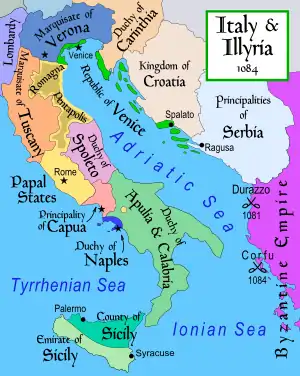1084
Year 1084 (MLXXXIV) was a leap year starting on Monday (link will display the full calendar) of the Julian calendar.
| Millennium: | 2nd millennium |
|---|---|
| Centuries: | |
| Decades: | |
| Years: |
| 1084 by topic |
|---|
| Leaders |
|
| Birth and death categories |
| Births – Deaths |
| Establishments and disestablishments categories |
| Establishments – Disestablishments |
| Gregorian calendar | 1084 MLXXXIV |
| Ab urbe condita | 1837 |
| Armenian calendar | 533 ԹՎ ՇԼԳ |
| Assyrian calendar | 5834 |
| Balinese saka calendar | 1005–1006 |
| Bengali calendar | 491 |
| Berber calendar | 2034 |
| English Regnal year | 18 Will. 1 – 19 Will. 1 |
| Buddhist calendar | 1628 |
| Burmese calendar | 446 |
| Byzantine calendar | 6592–6593 |
| Chinese calendar | 癸亥年 (Water Pig) 3780 or 3720 — to — 甲子年 (Wood Rat) 3781 or 3721 |
| Coptic calendar | 800–801 |
| Discordian calendar | 2250 |
| Ethiopian calendar | 1076–1077 |
| Hebrew calendar | 4844–4845 |
| Hindu calendars | |
| - Vikram Samvat | 1140–1141 |
| - Shaka Samvat | 1005–1006 |
| - Kali Yuga | 4184–4185 |
| Holocene calendar | 11084 |
| Igbo calendar | 84–85 |
| Iranian calendar | 462–463 |
| Islamic calendar | 476–477 |
| Japanese calendar | Eihō 4 / Ōtoku 1 (応徳元年) |
| Javanese calendar | 988–989 |
| Julian calendar | 1084 MLXXXIV |
| Korean calendar | 3417 |
| Minguo calendar | 828 before ROC 民前828年 |
| Nanakshahi calendar | −384 |
| Seleucid era | 1395/1396 AG |
| Thai solar calendar | 1626–1627 |
| Tibetan calendar | 阴水猪年 (female Water-Pig) 1210 or 829 or 57 — to — 阳木鼠年 (male Wood-Rat) 1211 or 830 or 58 |

Events
Europe
- March 31 – Emperor Henry IV besieges Rome and enters the city. He is crowned emperor by Antipope Clement III at Rome and receives the patrician authority.[1]
- May – Sack of Rome: Duke Robert Guiscard leads a Norman army (36,000 men) north and enters Rome; the city is sacked, and Henry IV is forced to retreat.
- Robert Guiscard returns with 150 warships in Illyria (modern Albania), and occupies Corfu and Kefalonia with the support of Ragusa and the Dalmatian cities.
- King Halsten Stenkilsson is killed and his brother Inge the Elder is deposed in Svealand (modern Sweden). Inge is replaced by his brother-in-law Blot-Sweyn.
Seljuk Empire
- The Seljuk Turks under Sultan Malik-Shah I conquer Byzantine Antioch, held by Philaretos Brachamios, an Armenian general, who seize power as a usurper.
Asia
Religion
- Pope Gregory VII, who is imprisoned by Henry IV in Castel Sant'Angelo, is freed by Robert Guiscard. He restores papal authority in Rome.
- Bruno of Cologne founds the Carthusian Order which includes both monks and nuns. He builds an hermitage in the French Alps.[3]
- Building work starts on Worcester Cathedral. Orchestrated by Bishop Wulfstan.
Births
- August 1 – Heonjong, Korean king of Goryeo (d. 1097)
- Alan I (le Noir), viscount of Rohan (d. 1147)
- Ali ibn Yusuf, ruler of the Almoravids (d. 1143)
- Bahram-Shah, ruler of the Ghaznavids (d. 1157)
- Charles I (the Good), count of Flanders (d. 1127)
- David I, king of Scotland (approximate date)
- Li Qingzhao, Chinese female poet and writer
- Rainier, margrave of Montferrat (approximate date)
- Rechungpa, Tibetan founder of the Kagyu school (d. 1161)
- Wang, Chinese empress of the Song Dynasty (d. 1108)
Deaths
- February 16 – Siegfried I, archbishop of Mainz
- June 28 – Ekkehard of Huysburg, German abbot
- October 10 – Gilla Pátraic, bishop of Dublin
- November 20 – Otto II, margrave of Montferrat
- Aghsartan I, Georgian king of Kakheti and Hereti
- Fujiwara no Kenshi, Japanese empress (b. 1057)
- Halsten Stenkilsson, king of Sweden (approximate date)
- Herfast (or Arfast), Norman Lord Chancellor
- Hoël II, duke of Brittany (House of Cornouaille)
- Saw Lu, king of the Pagan Kingdom (b. 1049)
References
- "Henry IV, Holy Roman Emperor". Encyclopedia Britannica. Retrieved August 8, 2018.
- E, Harvey G. (2000). History of Burma. Asian Educational Services. p. 36. ISBN 9788120613652.
- "Carthusian religious order". Encyclopedia Britannica. Retrieved August 8, 2018.
This article is issued from Wikipedia. The text is licensed under Creative Commons - Attribution - Sharealike. Additional terms may apply for the media files.